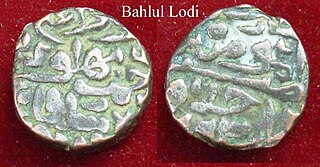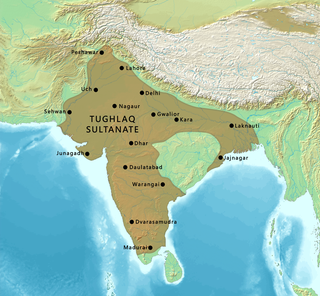
Muslim period in the Indian subcontinent (712–1757) is conventionally said to have started in 712, after the conquest of Sindh and Multan by the Umayyad caliphate. It began in the Indian subcontinent in the course of a gradual conquest. The perfunctory rule by the Ghaznavids in Punjab was followed by Ghurids, and Sultan Muhammad of Ghor (r.1173–1206) is generally credited with laying the foundation of Muslim rule in Northern India.

The Delhi Sultanate or the Sultanate of Delhi was a late medieval empire primarily based in Delhi that stretched over large parts of the Indian subcontinent, for 320 years (1206–1526). Following the invasion of South Asia by the Ghurid dynasty, five dynasties ruled over the Delhi Sultanate sequentially: the Mamluk dynasty (1206–1290), the Khalji dynasty (1290–1320), the Tughlaq dynasty (1320–1414), the Sayyid dynasty (1414–1451), and the Lodi dynasty (1451–1526). It covered large swaths of territory in modern-day India, Pakistan, and Bangladesh as well as some parts of southern Nepal.

Sultan Firuz Shah Tughlaq was a Muslim ruler from the Tughlaq dynasty, who reigned over the Sultanate of Delhi from 1351 to 1388. He succeeded his cousin Muhammad bin Tughlaq following the latter's death at Thatta in Sindh, where Muhammad bin Tughlaq had gone in pursuit of Taghi the rebellious Muslim governor of Gujarat. For the first time in the history of the Sultanate, a situation was confronted wherein nobody was ready to accept the reins of power. With much difficulty, the camp followers convinced Firoz to accept the responsibility. In fact, Khwaja Jahan, the Wazir of Muhammad bin Tughlaq had placed a small boy on the throne claiming him to be the son of Muhammad bin Tughlaq, who meekly surrendered afterwards. Due to widespread unrest, his realm was much smaller than Muhammad's. Tughlaq was forced by rebellions to concede virtual independence to Bengal and other provinces. He established Sharia across his realm.

The Sayyid dynasty was the fourth dynasty of the Delhi Sultanate, with four rulers ruling from 1414 to 1451 for 37 years. The first ruler of the dynasty, Khizr Khan, who was the Timurid vassal of Multan, conquered Delhi in 1414, while the rulers proclaimed themselves the Sultans of the Delhi Sultanate under Mubarak Shah, which succeeded the Tughlaq dynasty and ruled the Sultanate until they were displaced by the Lodi dynasty in 1451.

Jaunpur is a city and a municipal board in Jaunpur district in the Indian state of Uttar Pradesh. It is located 228 km southeast of state capital Lucknow. Demographically, Jaunpur resembles the rest of the Purvanchal area in which it is located.

Bahlul Khan Lodi was the chief of the Afghan Lodi tribe. Founder of the Lodi dynasty from the Delhi Sultanate upon the abdication of the last claimant from the previous Sayyid rule. Bahlul became sultan of the dynasty on 19 April 1451.

The Tughlaq dynasty was the third dynasty to rule over the Delhi sultanate in medieval India. Its reign started in 1320 in Delhi when Ghazi Malik assumed the throne under the title of Ghiyath al-Din Tughluq. The dynasty ended in 1413.

The Lodi dynasty was a dynasty that ruled the Delhi Sultanate from 1451 to 1526. It was the fifth and final dynasty of the Delhi Sultanate, and was founded by Bahlul Khan Lodi when he replaced the Sayyid dynasty.

Indo-Islamic architecture is the architecture of the Indian subcontinent produced by and for Islamic patrons and purposes. Despite an initial Arab presence in Sindh, the development of Indo-Islamic architecture began in earnest with the establishment of Delhi as the capital of the Ghurid dynasty in 1193. Succeeding the Ghurids was the Delhi Sultanate, a series of Central Asian dynasties that consolidated much of North India, and later the Mughal Empire by the 15th century. Both of these dynasties introduced Islamic architecture and art styles from West Asia into the Indian subcontinent.
Khan is a surname of Turko-Mongol origin, today most commonly found in parts of India, Pakistan, Afghanistan, Bangladesh, and Iran. It is derived from the historic title khan, referring to military chief or royalty. It originated as a hereditary title among nomadic tribes in the Central and Eastern Eurasian Steppe during antiquity and was popularized by Turkic dynasties in the rest of Asia as well as in Eastern Europe during the medieval period.

Khizr Khan was the founder of the Sayyid dynasty, the ruling dynasty of the Delhi sultanate, in northern India soon after the invasion of Timur and the fall of the Tughlaq dynasty. Khizr Khan was Governor of Multan under the Tughlaq ruler, Firuz Shah Tughlaq, and was known to be an able administrator. He did not take up any royal title due to fear of invasion by Amir Timur and contended himself with the titles of Rayat-i-Ala and Masnad-i-Aali or. During his reign, coins were continued to be struck in the name of previous Tughlaq rulers. After his death on 20 May 1421, he was succeeded by his son Mubarak Khan, who took the title of Muizz-ud-Din Mubarak Shah.

The Jaunpur Sultanate was a Muslim kingdom in northern India between 1394 and 1494, ruled by the Sharqi dynasty. It was founded in 1394 by Khwajah-i-Jahan Malik Sarwar, an eunuch slave and former wazir of Sultan Nasiruddin Muhammad Shah IV Tughluq, amidst the disintegration of the Delhi Sultanate's Tughlaq dynasty. Centred in Jaunpur, the Sultanate extended authority over Awadh and a large part of the Ganges-Yamuna Doab. It reached its greatest height under the rule of Sultan Ibrahim Shah, who also vastly contributed to the development of Islamic education in the Sultanate. In 1479, Sultan Hussain Khan was defeated by the forces of Afghan ruler Bahlul Lodi, Sultan of the Lodi dynasty of the Delhi Sultanate, which abruptly brought an end to independent Jaunpur and its reabsorption into the Delhi Sultanate.

Kotla Mubarakpur, a medieval famous urban village, is a market place with residential colony in South central part of New Delhi. Kotla Mubarakpur classified by the Delhi Development Authority (D.D.A.) as an Urban Village which is dominated by Baisla gotra of Gurjars, it is situated within touching distance of South Extension. Defence Colony lies to its east. Nearest Delhi Metro stations are South Extension, Dilli Haat - INA and Lajpat Nagar. Its history can be traced to the prominent tomb of Muizud Din Mubarak Shah, son of Khizr Khan of the Sayyid dynasty of the fifteenth century Delhi Sultanate rule in India, and its adjoining mosque. There are several other tombs of Lodi Dynasty period such as the Darya Khan's tomb, Kale Khan ka Gumbad, Bare Khan ka Gumbad, Chote Khan Ka Gumbad and Bhure Khan ka Gumbad, and also a Baoli.
Firouz, Pirouz, Feroz, Fayrouz, Phiroj, are masculine given names of Persian origin. It is ultimately derived from Middle Persian Pērōz, meaning "victorious, triumphant or prosperous", mentioned as Perozes (Περόζης) in Latin and Greek sources.
Feroz or Firuz and Firuze is a Persian name meaning 'victorious', derived from the middle Persian name Peroz or Piruz. Related names are Phiroze, Feroze, and Parviz.
Qāḍī Sayyid Rāfiʿ Muḥammad Dasondhi was a scholar of repute from Sakras, District Gurgaon. He belonged to the family of Gardēzī Sadaat.
Tughlaq Tombs in the Indian subcontinent are mostly simple, monotonous and heavy structures in Indo-Islamic architecture built during the Tughlaq dynasty (1320–1413). They look more like fortresses with walls surrounding them and have restrained decoration and embellishment compared to both earlier and later Indian Islamic tombs. Their architecture lacks the influence from Hindu temple architecture and craftsmanship which was later found in Lodi and Mughal architecture. But Hindu influence on Tughlaq buildings was not totally absent. Features of Hindu influences on Tughlaq architecture include the flat lintel instead of pointed arch, pillars, windows with balconies and eaves and railings.
Raja Bahadur Nahar Khan was the ruler of Mewat and the progenitor of Khanzada Rajput clan who were themselves a sub-clan of Jadaun Rajputs. His original name was Sambhar Pal and later came to be known as Nahar Singh. He and his brother Sopar Pal embraced Islam under the influence of Firuz Shah Tughlaq after he annexed their estates. He was also known as Wali-e-Mewat Raja Bahadur Nahar Khan

Turkic peoples have historically been associated as one of the non-indigenous peoples to have ruled areas of India and the Indian subcontinent. Although modern day Turks in India are very small in number, and are likely recent immigrants from Turkey. In the 1961 census, 58 people stated that their mother tongue was Turkish. According to the 2001 census, 126 residents of India stated their place of birth as Turkey. In a state visit during early 2010, Prime Minister Abdullah Gül of Turkey met Turkish expatriates living in India and handed out Hindi-Turkish dictionaries to Turkish students in New Delhi.












